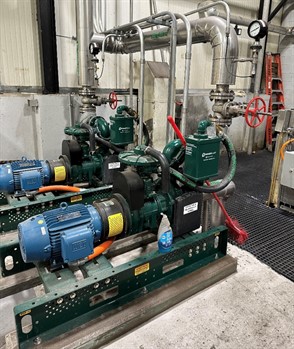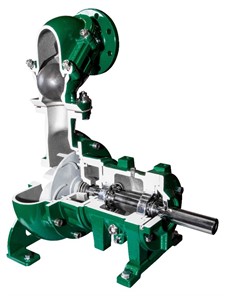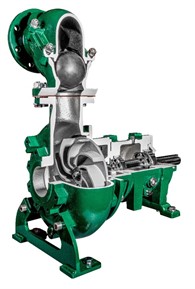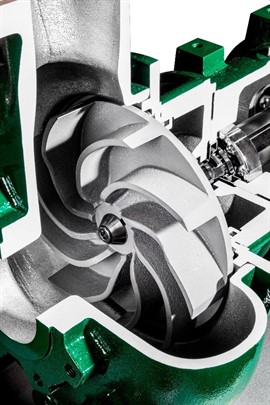Finding a Reliable & High-Performing Pumping System for the Rendering Industry
The importance of the impeller in handling animal byproducts.
Jeff Burch, Hutcheson Engineering and Adam Schantz, Franklin Electric
 Reducing downtime on the production floor of rendering facilities is not just critical—it can be the difference between generating significant daily revenue or losing it. Wasted product, lost labor expenses and reduced production all add up. Whether a user’s operations process agricultural products or render animals, their pumping equipment needs to stand up to some specific, and often brutal, challenges. If the pumping systems supporting a main chain production line are causing downtime issues, it can be catastrophic. What is the solution to handling harsh byproducts and waste? What should users look for when comparing a trash or chopper pump to a pump with a recessed impeller design?
Reducing downtime on the production floor of rendering facilities is not just critical—it can be the difference between generating significant daily revenue or losing it. Wasted product, lost labor expenses and reduced production all add up. Whether a user’s operations process agricultural products or render animals, their pumping equipment needs to stand up to some specific, and often brutal, challenges. If the pumping systems supporting a main chain production line are causing downtime issues, it can be catastrophic. What is the solution to handling harsh byproducts and waste? What should users look for when comparing a trash or chopper pump to a pump with a recessed impeller design?
This article takes a closer look at solids handling from the point-of-view of the animal-processing side of the food industry, outlining some important questions owners should consider to help avoid unplanned equipment outages and expensive downtime.
How Well can the Pump Handle Solid Animal Byproducts?
Pumping systems in food production operations need to eliminate a host of unforgiving and large solids like bones, hooves, nails and hair from a harvest floor. If a pumping system goes down, even if it is only for an hour, issues may develop on the harvest floor that stop the harvest chain, resulting in thousands of dollars in revenue being lost almost immediately. If these solids can pass through without contact, the pump keeps the chain moving. The pump’s impeller design can play a large role in this reliability. A recessed impeller design combines the efficiency characteristics of a self-priming pump with the solids handling capabilities of a chopper pump. This makes it ideal for applications that need to pass solids while also handling flows to meet the application’s high total dynamic head (TDH) and gallons per minute (gpm) requirements. Recessed impellers ensure only about 15% of the solids that pass through the pump come in contact with the impeller. Combining this impeller design with a vacuum-assisted priming chamber allows the pump to move both solids and fluids efficiently.
How Well can the Pump Handle Acid or Harsh Liquid Waste?
Speaking of fluids, depending on the type of product a facility is processing, the waste generated can include not only solids, but harsh debris that is acidic, abrasive and aggressive. Consider the overall components used in the pump and their ability to withstand acidic liquids on a regular basis. Will they stand up to the abuse, and are they easy to maintain? When evaluating the durability of a pump for the production floor and rendering pits, consider all the internal and external parts and the extreme conditions they will see.
- Does the pump use a ball check valve to avoid clogging from passed-through solids? Does it utilize a flapper check valve that will not handle abrasive debris without extreme wear and repair needs?
- Is there a need to consistently replace rotating assemblies on installed pumps to maintain the desired level of performance?
- Does the pump include wear plates and chopper blades that will need to be monitored, adjusted and replaced?
- Are there cutters in the pump that need to be sharpened or wear plates that need to be maintained?
- Are there internal wetted parts that require maintenance to extend the life expectancy of the pump?
Overall, the goal is to look at how the system not only performs day to day, but also how it is engineered. Will it save users time and money long-term or cost them in lost production?
What Type of Priming System is Facilitating the Pump’s Operation?

A pump with a vacuum-assisted priming chamber is designed for continuous operation. Like a self-priming pump, a vacuum-assisted priming system allows the pump to prime on its own and reprime if prime is ever lost. A vacuum priming system eliminates the need for initial fill of the case, and the internal valve system eliminates carryover and exposure to pumpage. It also stops the pump from running dry, avoiding premature seal and rotating assembly failure. This priming system cuts the time to prime by 40% and reduces the seal and bearing failures on the rotating assemblies common to trash pumps. It is designed for continuous operation and eliminates the need for water lines running to the pump.
These pumps also offer some unique benefits that help production floor operations run more smoothly overall. When using a pump with a vacuum-assisted self-primer, there is no need to run an additional water line to the supply pump casing before starting the system. This step is eliminated, and the pump will still prime. In addition, a vacuum-assisted priming system provides additional capabilities to overcome pinhole leaks, blockages and more on the suction line, overcoming other maintenance concerns.
Capital Expenditures vs. Operational Expenditures
One final consideration is the cost of the pump itself. While the capital expenditure of a recessed impeller pump may be more initially than a trash pump, it offers high performance and long life that reduces maintenance and operating costs. For example, consider a hog facility that experienced issues with a trash pump that caused main chain issues and resulted in a shutdown for maintenance. The downtime equated to nearly two hundred thousand dollars in lost production an hour. After a few hours of downtime, their second shift labor had to be sent home. Product had to be scrapped. At the end of the day, they lost over a million dollars.
Some producers keep additional inventory of trash pumps on-hand, allowing for a swap out if any issues arise with a current pump. The cost of this inventory overhead and management also adds up. With a reliable, high-performing pump that is built to withstand the demands of solid waste, harsh liquids and more, no extra inventory is needed.
Not all pumping systems can handle the brutal conditions that exist in a food processing facility. That is why it is critical to evaluate a pumping system based on how it is designed and what it is engineered to handle. Looking at the pump’s impeller design, priming system, overall construction and durability of components can make the difference between costly shutdowns and continuous, reliable operation.


